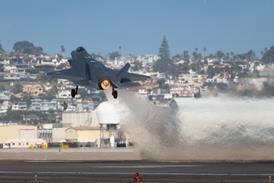DAVID LEARMOUNT, OPERATIONS AND SAFETY EDITOR
Winning back passenger confidence is vital for the air transport industry
While analysts forecast that other industries will recover from the economic downturn within the normal cyclical period of one to three years, air transport, and the travel and tourism industries that depend on it, will lag behind, weighed down by the unpredictable consequences of 11 September.
Winning back passenger confidence, therefore, is the name of the game for airports and airlines, and clear answers on where to go with air transport security is one of the imperatives. The strategies have to be provided quickly, but also credibly. Security needs not just to be provided but to be seen to be provided.
As the state directly hit by the 11 September atrocity and most likely to be targeted by factions who would use terrorism, the USA has been going to great lengths to be seen to be acting on security. Fortress cockpits and sky marshals are the most highly played reactions, yet these dramatic measures have had the unwanted side-effect of exaggerating to passengers the risks they face with air travel.
If there is an incident involving sky marshals in which passengers are hurt on board, and it is discovered afterwards not to have involved terrorists, potential passengers would be given yet another reason to avoid flying. Although there is no sign that the USA has any intention of moving its security concentration from the air to the ground, it may be forced to do so.
It has taken Europe 20 years gradually to accept the security culture associated with airports and airlines. The USA is going to have to work more quickly than that, but in doing so it will be losing its prized no-nonsense, quick-fire domestic air travel system. This goes against the grain, and to prove it, kerbside check-in has been re-established against all advice from security experts.
As the International Air Transport Association has been saying for nearly 10 years, while security must be both visible and reassuring, techniques must become faster and less intrusive as well as maintaining or improving effectiveness.
Biometric techniques for positive identification would only be part of that process, but they have more potential to speed up customs and immigration at airports than other security procedures - though integrating the two would be the ideal.
Biometrics does, however, have the potential to reduce ticket fraud, particularly e-ticket fraud, and that, in itself, constitutes a security measure. They also have the potential to allow multiple checks to track a passenger's progress from landside to the gate - or through the flight-transfer process - without becoming annoyingly intrusive.
Europe is chugging slowly through the post-11 September consultation process to work out what, if anything, its security response should be. The theory is that, since the destruction of Pan American flight 103 over Lockerbie in 1988, Europe has been setting up a comprehensive security infrastructure.
The final step that some of the European Civil Aviation Conference states have to take is complete hold-baggage scanning, but when that has been done, the system should be able to counter security threats by varying alertness states according to intelligence inputs.
The lack of intelligence which characterised 11 September has to be corrected, but the air transport industry has no direct influence in this regard - it can only hope things will improve. And one of Europe's reasons for being apparently so slow to take action is that the nature of future threats has to be identified - as do the USA's most likely targets - to ensure the effectiveness of any new countermeasures.
Source: Flight International























